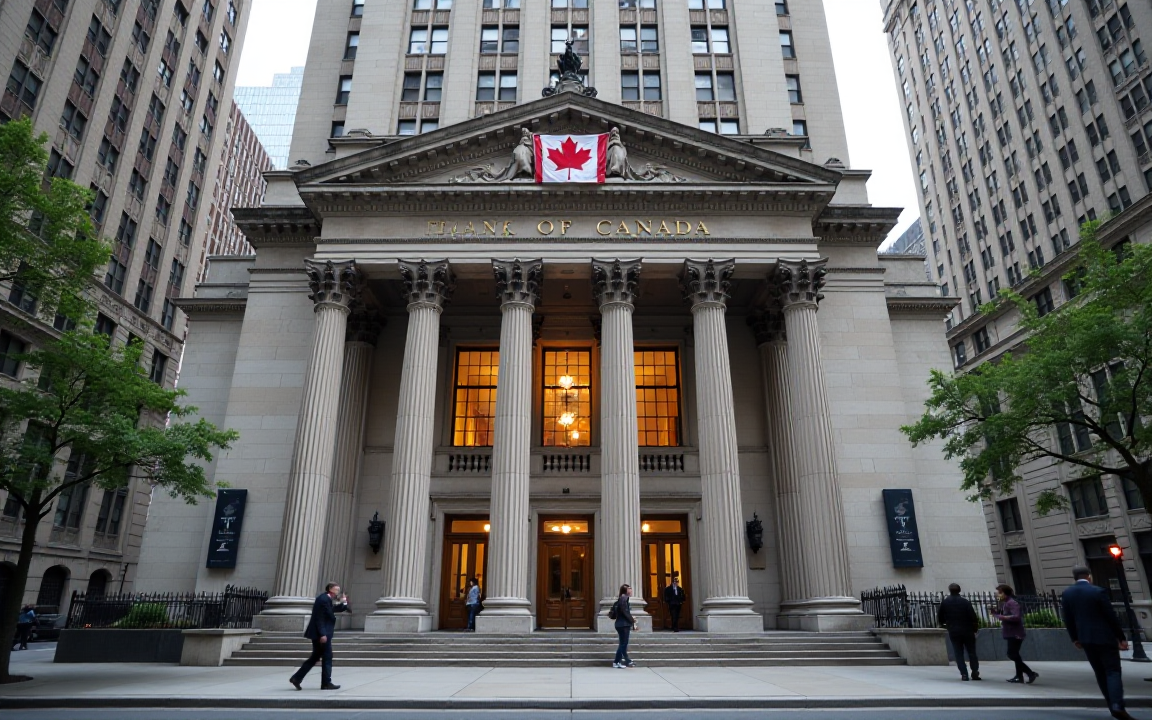The Bank of Canada (BoC) kept its benchmark interest rate unchanged at 2.75% for a third straight meeting on Wednesday as expected, as it treaded carefully amid global trade tensions.
While the immediate danger of an all-out global trade war may have receded, confusion regarding US trade policy still looms over the Canadian economic landscape.
“Since April, the risk of a severe and escalating global trade conflict has diminished,” the central bank said in its quarterly monetary policy report. “Nevertheless, how US trade policy will unfold remains highly uncertain.”
For the second consecutive quarter, the Bank of Canada declined to make official economic estimates, instead outlining three alternative scenarios moulded by the direction of global tariffs.
Three scenarios, one message: Uncertainty persists
Rather than providing point forecasts, the bank presented a range of possible outcomes.
In the baseline scenario, which assumes that present tariffs on steel, aluminium, autos, and non-compliant imports under a continental free trade agreement are maintained, Canada’s GDP is expected to decrease by 1.5% in the second quarter of 2025.
Growth would then pick up modestly, increasing by 1% in the second half of the year before reaching 1.8% in 2027.
In this scenario, inflation is expected to remain close to the Bank of Canada’s 2% target for the next two years.
In other scenarios, it examines the easing and intensifying of global tariffs. De-escalation would lead to a decline in tariffs, thereby enhancing growth prospects and mitigating inflation.
On the other hand, a situation with higher tariffs would be a drag on the economy and raise immediate cost pressures.
Governor Tiff Macklem stressed the conditionality of future policy changes. “Canada’s economy is demonstrating resiliency thus far… Inflation is approaching our 2% objective, but we detect signs of underlying inflationary pressures,” he said.
Eyes on August 1: US tariff threat looms
Both the markets and policymakers are watching closely as the US and Canada attempt to hammer out a new trade agreement ahead of the August 1st tariffs deadline.
US President Donald Trump has threatened to levy 35% tariffs on some Canadian exports should an agreement not be reached, a situation which could very well change the BoC’s current wait-and-see approach quite drastically.
In reaction to such dangers, Macklem stated, “We will be closely following tariff developments and assessing indicators of underlying inflation.”
“If a weakening economy puts further downward pressure on inflation and the upward price pressures from the trade disruptions are contained, there may be a need for a reduction in the policy interest rate,” he added.
Rate cuts are still on the table
Although the BoC has paused its aggressive easing program, which saw interest rates drop by 225 basis points beginning in June of last year, it remains open to future rate reduction if economic conditions worsen.
“The Bank appears to be getting a little more comfortable with the idea that the Canadian economy will require additional interest rate cuts in the future,” said Andrew Grantham, senior economist at CIBC Capital Markets.
“It is not there yet, and upcoming data will remain more important.”
Market pricing currently indicates a more than 81% chance of another rate hold in September, with traders not expecting any additional cuts for the rest of the year.
Markets react cautiously
The Canadian dollar fell 0.30% after the Bank of Canada’s pronouncement, trading at 1.3811 to the US dollar, or 72.41 cents.
The loonie’s movement reflected both the central bank’s dovish tone and broad-based rise in the US currency.
“While this latest decision to leave rates unchanged was as expected, the BoC retains an easing bias in its most recent set of communications,” said Nick Rees, senior FX market analyst at Monex Europe Ltd.
“Any decision to resume cutting, however, is once again seemingly predicated on the Governing Council gaining more clarity over an uncertain outlook, suggesting to us that further rate cuts may be some time away yet.”
Doug Porter, chief economist at BMO Capital Markets, also noted a dovish tone in the bank’s communications.
“I assumed there was a bone thrown to the doves here. “They’ve certainly left the door open for further rate cuts if inflation moderates or the economy weakens.”
A balanced but cautious approach
Overall, the BoC maintained a cautious tone, acknowledging signals of resilience such as strong job growth and stable core inflation but staying wary of downside risks.
Andrew Kelvin, head of Canadian and global rates strategy at TD Securities, welcomed the central bank’s flexibility.
“The Bank of Canada is making a sensible decision by leaving as many alternatives open as possible. Rather than having just one option, people are choosing several scenarios,” he explained.
Kelvin continued to state that “what is evident to me is that they are unwilling to declare that the worst is behind them. Despite the high job numbers, some caution is advised.”
“They’re not panicked, and they’re not certain that the economy is safe, so they’re simply trying to adopt a balanced approach as a result,” he concluded.
With key trade decisions coming and inflation pressures still at play, the Bank of Canada is in wait-and-see mode, keeping steady but far from declaring triumph.
The post Bank of Canada holds rate at 2.75%, keeps easing bias amid trade uncertainty appeared first on Invezz

